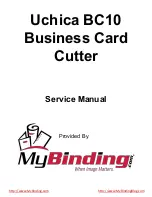
8
GENERAL INFORMATION ABOUT
USING THE SWITCHBLADE
CONTROLLING THE SWITCHBLADE
The Switchblade can be controlled using any or all of the following:
1.
Front Panel
controls on the Switchblade allow the user to scroll through menus using the MODE switch, choose items
within menus using the SELECT switch, and change selected items using the UP/DOIT or DOWN switches. In addition,
presets may be scrolled through by pressing the UP or DOWN switches while in play mode with the cursor under the preset
number or may be randomly selected using the PRESET MANAGER (see below).
2.
Footswitch
control is available by attaching a single or dual momentary footswitch to the “foot” jack on the back panel and
the type of footswitch used (momentary on or momentary off) is automatically detected during “power up”. Using this feature
the user can scroll through presets or banks of presets, and can also use it with the SWEEP function (see the Autosweep
Parameters menu) to “fire” sweeps using the presets. If you do not have a MIDI foot controller, but still wish to select presets
on your other MIDI devices, you can use the footcontroller to not only select the presets on the Switchblade, but also to tell the
Switchblade to transmit MIDI to your other devices. You can use the Footswitch at the same time as a MIDI foot controller
for extra control.
3.
MIDI
control is probably the most common method of control and gives the Switchblade user an array of options. A MIDI
controller can be used to select presets, a MIDI continuous controller can be used for continuous control within presets, and
presets on MIDI devices attached to the Switchblade can be selected using the Switchblades ability to transmit Program
Change commands when presets on the Switchblade are selected.
4.
Computer
control (i.e. Studio Automation) is probably the most advanced method of controlling the Switchblade 8B.
Using the MIDI System Exclusive format, the user can create and remove patches and assign Controller values to patches.
Graphic faders available with many sequencer packages can then be used to vary the gains of individual or group patches.
THE PRESET MANAGER
The Preset Manager is a preset storage area consisting of 20 banks with 10 empty locations call "items" in each bank. Any
number of presets - up to a maximum of 10 - can be loaded into a bank, in any order. Even the same preset can be loaded into
different areas in the bank. For example, a bank might have preset 12, 27, 12 and 50 loaded in that order. A second bank
might only have 2 presets loaded, such as 22, and 33.
The Preset Manager is used to take advantage of the "foot" jack on the back panel of the Switchblade. This jack accepts a
single or dual momentary mechanical type footswitch. If a single switch is used, then each time the switch is pressed, the
"item" location increments by one. When the last preset in the bank is reached, the first item in the bank is loaded again next
time the switch is pressed. For example, if only 2 presets are loaded into a bank, each preset will be alternately loaded each
time the switch is pressed.
If a dual footswitch is used, then the second switch will increment to the next bank. Only those banks that have presets loaded
into them are called up.
The preset manager can be used simultaneously with a MIDI controller. The MIDI controller will always bypass the preset
manager and call presets up directly. The footswitch on the other hand always goes through the preset manager to find the
presets to load.
For more information on how to use the Preset Manager see the Preset Manager Menu in the Programming Group.
THE REMOTE ADJUST FEATURE:
This feature allows the user to re-program the levels of certain selected outputs of the current preset while in “PLAY” mode
using a simple footswitch. It allows you to match the overall levels between presets without having to re-program each preset
using the programming mode. These adjustments are permanently written into the user memory and are therefore retained
even after power down. When used as recommended, this feature will not change the “mix” of the preset, but rather only its
final output level with respect to other presets.








































